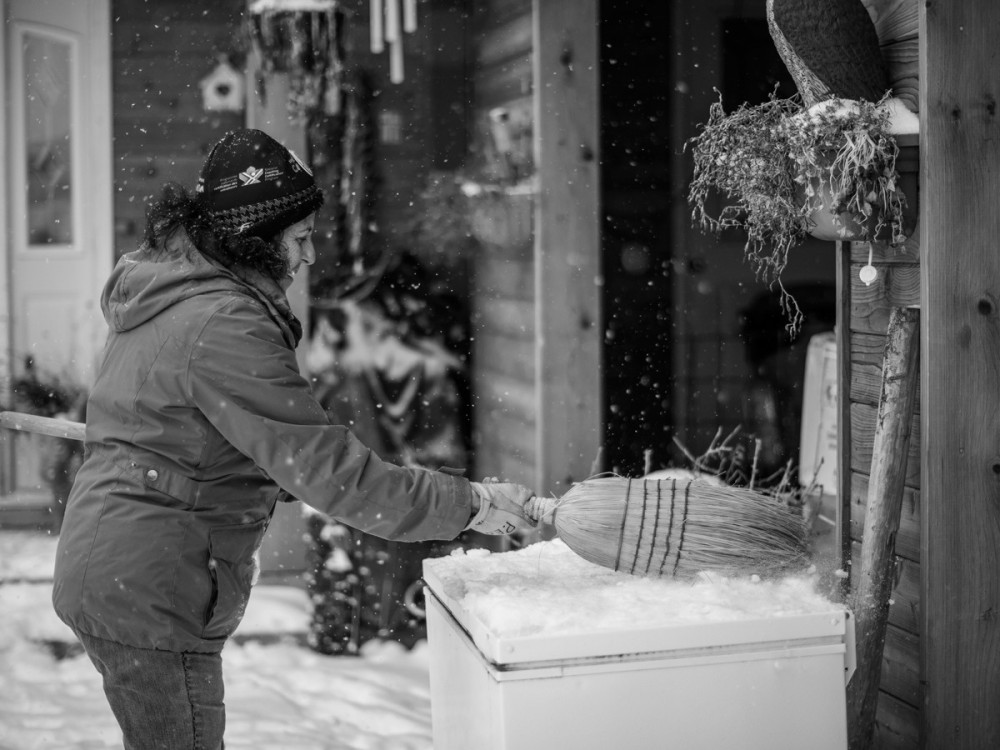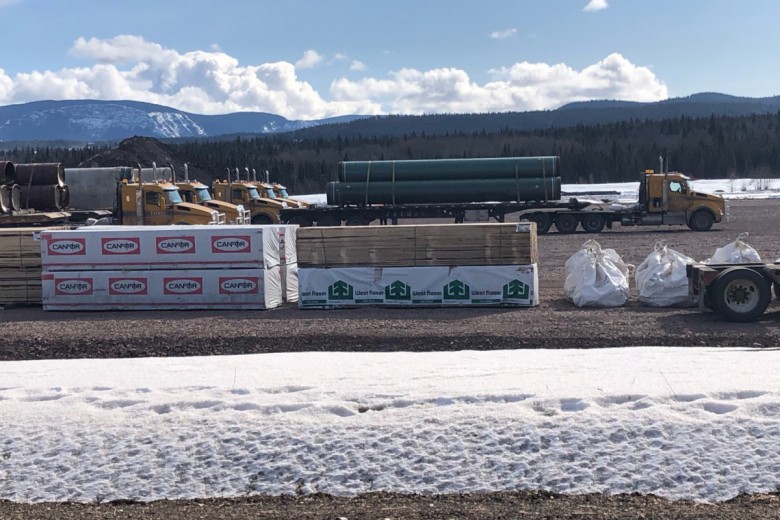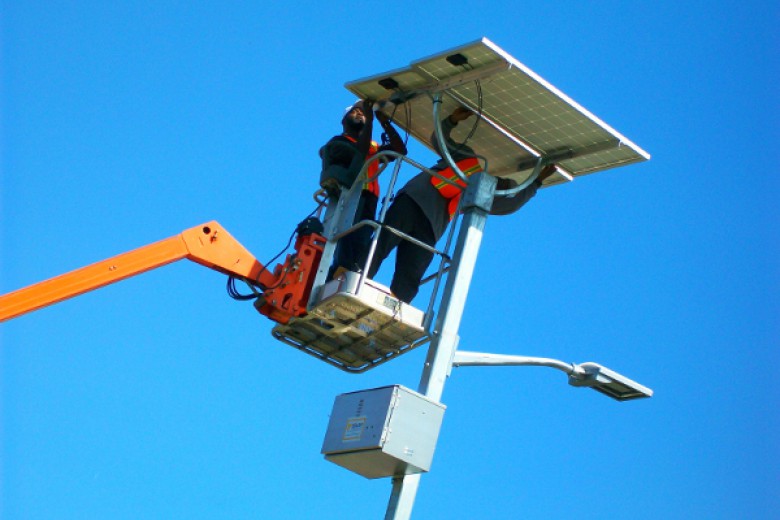In January 2016, farmers and First Nations members set up a peaceful two-month winter camp in an effort to stop the $10.7 billion Site C dam on B.C.’s Peace River. The dam would flood 145 kilometres of the river and its tributaries, destroying hundreds of archeological and heritage sites – including Indigenous burial grounds – as well as some of Canada’s richest farmland and critical habitat for dozens of species vulnerable to extinction. Third-generation farmers Ken and Arlene Boon are among 70 Peace River Valley residents who will lose homes and property to the dam. Esther Pedersen will also lose her house and property.
Helen Knott and Yvonne Tupper are members of Treaty 8 First Nations whose traditional territory includes the Peace River Valley. The area slated for flooding is the last remaining stretch of valley still available to First Nations for traditional practices guaranteed to them in a treaty their ancestors signed in 1900. The rest of the valley, along with much of the surrounding region, has been taken up by industrial development.
Two weeks after the camp was established at the Rocky Mountain Fort heritage site, scientist David Suzuki and Grand Chief Stewart Phillip, the president of the Union of B.C. Indian Chiefs, visited the remote location by helicopter to support the campers.
One week after David Suzuki and Grand Chief Stewart Phillip visited the Rocky Mountain Fort camp, BC Hydro filed an injunction and enforcement order to remove the encampment and proceed with logging. The campers had fully expected an injunction, but they were unnerved when B.C.’s Liberal government, in an unprecedented turn of events, also authorized the law firm of Fasken Martineau DuMoulin (since renamed Fasken) to launch a civil suit against five of the campers and a camp supporter, all but one of them women.
The 13-page civil suit was astonishing in its audacity. It accused the Rocky Mountain Fort campers of conspiracy, intimidation, trespassing, creating a public and a private nuisance, and intentionally interfering with economic relations by unlawful means. Those charges, one unaffiliated lawyer said, placed their peaceful protest on par with the occupation of Oregon Malheur National Wildlife Refuge by armed militants, which was happening around the same time. Helen Knott, Yvonne Tupper, and Ken and Arlene Boons were all named in the suit. Coastal resident Lynn Chapman, who had spent more nights at the camp than either Knott or Arlene Boon, was not named. Nor were the many First Nations members who had stayed at the camp or visited during the day, including all of the Elders and two former Saulteau First Nations chiefs, Bud and Art Napoleon.
The 13-page civil suit was astonishing in its audacity.
Knott and Tupper were the only First Nations members to be singled out. The suit seemed carefully thought out: it was an attempt to target and punish those local residents who were likely to be among Site C’s most vexing opponents and whose names would not generate headlines. Knott wrote eloquently: “In this moment I am heartbroken, stunned, angry, confused, mildly numb, utterly perplexed, and unsure of how to proceed. I had to take myself away from reading my grad-school texts in order to write because the feelings I needed to process kept pestering me, much [like] northern bush mosquito[e]s that can penetrate through thick clothing. I couldn’t block it out.”
The fifth person named in the suit was local resident Verena Hofmann, the red-haired, freckled mother of a two-year-old boy. Hofmann had only stayed at the camp for one or two nights at a time, but she had helped transport people to it, including First Nations Elders, and she had publicized it widely on social media. Later, she explained that she was motivated by “feeling helpless and feeling frustrated” about the impending destruction of the valley and the lack of “weight or bearing” given to the fact-based case against Site C, pointing out that “people’s voices were not being heard.” The Rocky Mountain Fort camp, Hofmann said, was the only step left for local residents to protest the dam: “We were backed into a corner and people needed to do something.”

Esther Pedersen, who had visited the camp only once, for 15 minutes, was the sixth person targeted. Pedersen had used an outdoor freezer to collect food for the camp from community members. She had also permitted the use of her farm for the three chartered helicopter flights that ferried survival shacks, fire extinguishers, supplies, and visitors to the camp’s site. And she had allowed First Nations members and many other community members to access her land to reach the Treaty 8 shack, which she described as “a place where people can come out and watch the destruction of the valley.” On the day that Suzuki and the grand chief flew to the camp from the Pedersen farm, there had been an extra seat in the helicopter, and Pedersen had jumped in for a fleeting visit, zipping back to her farm and business duties when the helicopter returned to pick up the shack on a second flight.
One lawyer characterized the inclusion of Hofmann and Pedersen in the suit as a warning shot across the bow for anyone who hoped to support the camp with food and financial donations or who might post information about the camp on social media. If that were not enough of a deterrent, BC Hydro included the names of John Doe and Jane Doe in the suit, leaving the door wide open to naming future campers and other supporters, even if they never visited the site.
“We were backed into a corner and people needed to do something.”
And that was far from all: BC Hydro also sued the campers named in the civil suit for damages, contending that the camp had caused irreparable harm and considerable expense. The Crown corporation claimed general damages, punitive damages, costs, and interest. The bill, lawyers later suggested, could total as much as $420 million. At that point, Pedersen started referring to the outdoor freezer as her $420-million appliance. Notably, BC Hydro refused to divulge the amount of money that hydro customers would pay for filing the civil suit, or the total amount of its legal fees related to Site C.*
The civil suit was accompanied by hundreds of pages of affidavits that unnerved the campers. They had fully expected an eventual injunction and enforcement order, but they did not anticipate being sued by their own government. The campers had no idea that BC Hydro’s lawyers had been monitoring their personal Facebook pages, Twitter feeds, Instagram accounts, blogs, and other social media, and even collecting information about their family businesses. They had written freely about the peaceful camp on social media and engaged with BC Hydro’s security investigators in good faith, and now everything they had said was being used against them in a civil suit.
On New Year’s Day, by the Moberly River bridge, Knott had had the first of many uncomfortable encounters with the security guards and investigators hired by BC Hydro contractors. She wrote about that day in a blog:
“I went to where they built the bridge, where they crossed the Moberly River, because I wanted to see where they had cleared the land and offer tobacco for the trees and the loss of the living forest and animal homes. I was told not to cross the bridge to where they cleared so I went to the frozen river to pray. As I stood there in prayer the security man got out to film me and record my ‘doings.’ I prayed for him too. He got back in the vehicle by the time I was done praying but apparently a Native in prayer is something to be feared and to record.”
In the civil suit, the interaction was recorded as “helen knott incursion into operational area” at 1:25 p.m. The names of some of Knott’s Facebook friends who’d liked her post, and their written comments about it, were included in the affidavit – another legal sortie that might deter other people from any kind of involvement in Site C protests.
The day before Knott prayed, a security guard had notified the campers that they were being evicted from BC Hydro land. “I told him I have a right to be here,” Knott had written on her Facebook page, in a post used by BC Hydro as legal evidence against her. “I’m exercising my inherent right and as a Treaty 8 member I have a right to camp and be on the land within my territory…. They hadn’t the right to be clearing on Crown land while there are court cases pending.”
“As I stood there in prayer the security man got out to film me and record my ‘doings.’ I prayed for him too.”
BC Hydro’s affidavits for the civil suit contained, as exhibits, screenshots of Facebook pages, and it was through this that some campers discovered that their pages were no longer personal and private. Evidence against Arlene Boon, who had a public Facebook page, included a February post in which she stated: “Day 45. I may have froze my feet off, but I am still here at the Rocky Mountain Fort!” Evidence against Tupper included a GoFundMe.com fundraising page that she had set up to collect non-food donations for camp supplies, along with the names of some of the people around the province who had donated to the page, the amount each contributed, and their supportive comments.
Print, radio, and TV interviews the campers had given, mostly locally, had been transcribed by a company contracted by BC Hydro and were included in the affidavit. In one CBC interview, Tupper had told security guards, “We’re having a peaceful protest to identify our lands and post that this is Treaty 8 territory, and you’re trespassing.” Another of Tupper’s postings that made it into an affidavit, though intended to incriminate her, summed up the protective spirit of the winter camp: “No injunction, no civil suit will ever take away 44 days of no destruction.”
On December 11, 2017, B.C.’s new NDP government announced it will continue building the Site C dam, now a $10.7-billion project, even though B.C. has no need for the electricity. Peace River Valley landowners and First Nations continue their fight to stop the project. In January 2018, West Moberly First Nations and Prophet River First Nation launched a civil action alleging that Site C unjustifiably infringes upon their constitutional rights under Treaty 8.
*A Freedom of Information request made by the author, requesting the total amount of money that BC Hydro had spent on legal fees for Site C, was answered with a single line, which said the expenditure was subject to attorney-client privilege – a curious response considering that the clients in this case were BC Hydro customers.
Excerpted with permission from Breaching the Peace: The Site C Dam and a Valley’s Stand against Big Hydro by Sarah Cox. UBC Press 2018; Vancouver and Toronto.







